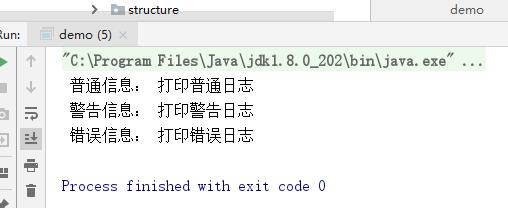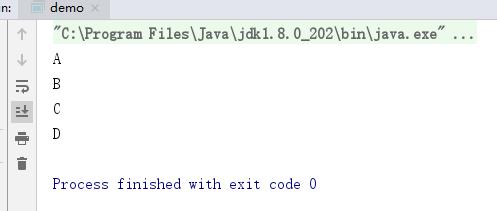设计模式-行为型模式讲解一(责任链命令迭代器)
Posted 小毕超
tags:
篇首语:本文由小常识网(cha138.com)小编为大家整理,主要介绍了设计模式-行为型模式讲解一(责任链命令迭代器)相关的知识,希望对你有一定的参考价值。
一、行为型设计模式
上篇,我们呢讲解了结构型设计模式,包括 适配器模式、桥接模式、组合模式、装饰者模式、享元模式、代理模式、外观模式。
文章地址(适配器、桥接、组合、享元):https://blog.csdn.net/qq_43692950/article/details/120248267
文章地址( 装饰者、外观、代理):https://blog.csdn.net/qq_43692950/article/details/120249265
这篇文章我们来讲解下行为型设计模式:主要用于描述类或对象之间的交互或职责的分配,为设计类的交互和职责分配做指南。
在本文主要介绍:责任链、命令、迭代器模式。
二、责任链模式
责任链模式(Chain of Responsibility Pattern)为请求创建了一个接收者对象的链。这种模式给予请求的类型,对请求的发送者和接收者进行解耦。
在这种模式中,通常每个接收者都包含对另一个接收者的引用。如果一个对象不能处理该请求,那么它会把相同的请求传给下一个接收者,依此类推。
优点是降低了耦合度,它将请求的发送者和接收者解耦。简化了对象,使得对象不需要知道链的结构。 增强给对象指派职责的灵活性,通过改变链内的成员或者调动它们的次序,允许动态地新增或者删除责任。 增加新的请求处理类很方便。
举个例子:在平时开发中,我们经常需要打印日志来查看一些信息,但打日志时我们都会指定一个日志级别,比如 INFO、WARN、ERROR等,指定不同的级别打印的日志存储的文件是不同的,这种场景就可以使用责任链设计模式来设计解决。
下面使用程序演示下上面的例子:
- 定义日志接口
public interface LoggerInterFace {
//指定下一个目标
void setNextLogger(LoggerInterFace nextLogger);
//打印日志
void logMessage(int level, String message);
//日志格式
void writeFormat(String message);
}
- 定义日志抽象模板
public abstract class AbstractLogger implements LoggerInterFace {
public static int INFO = 1;
public static int WARN = 2;
public static int ERROR = 3;
private int level;
private LoggerInterFace nextLogger;
public AbstractLogger(int level) {
this.level = level;
}
@Override
public void setNextLogger(LoggerInterFace nextLogger) {
this.nextLogger = nextLogger;
}
@Override
public void logMessage(int level, String message) {
if (this.level == level) {
writeFormat(message);
}
if (nextLogger != null) {
nextLogger.logMessage(level, message);
}
}
}
- 定义Info级别的实现
public class InfoLogger extends AbstractLogger {
public InfoLogger(int level) {
super(level);
}
@Override
public void writeFormat(String message) {
System.out.println(StringFormatter.concat(" 普通信息:", message).getValue());
}
}
- 定义Warn级别的实现
public class WarnLogger extends AbstractLogger {
public WarnLogger(int level) {
super(level);
}
@Override
public void writeFormat(String message) {
System.out.println(StringFormatter.concat(" 警告信息:", message).getValue());
}
}
- 定义Error级别的实现
public class ErrorLogger extends AbstractLogger {
public ErrorLogger(int level) {
super(level);
}
@Override
public void writeFormat(String message) {
System.out.println(StringFormatter.concat(" 错误信息:", message).getValue());
}
}
- 定义日志工厂,定义责任链的顺序
public class LoggerFactory {
public static LoggerInterFace getLogger() {
//定义责任链的顺序
List<AbstractLogger> list = new LinkedList<>();
list.add(new ErrorLogger(AbstractLogger.ERROR));
list.add(new WarnLogger(AbstractLogger.WARN));
list.add(new InfoLogger(AbstractLogger.INFO));
for (int i = 0; i < list.size() - 1; i++) {
list.get(i).setNextLogger(list.get(i + 1));
}
return list.get(0);
}
}
- 演示
public class demo {
public static void main(String[] args) {
LoggerInterFace logger = LoggerFactory.getLogger();
logger.logMessage(AbstractLogger.INFO, " 打印普通日志");
logger.logMessage(AbstractLogger.WARN, " 打印警告日志");
logger.logMessage(AbstractLogger.ERROR, " 打印错误日志");
}
}

三、命令模式
命令模式(Command Pattern)是一种数据驱动的设计模式,请求以命令的形式包裹在对象中,并传给调用对象。调用对象寻找可以处理该命令的合适的对象,并把该命令传给相应的对象,该对象执行命令。
优点是降低了系统耦合度,新的命令可以很容易添加到系统中去。
还是用原先画各种形状的例子来说,我们可以采用命令设计模式来设计,绘画不同的形状就将对应形状的实现传递给命令执行器,以一种统一的命令的形式来做不同的操作。可以有效降低耦合性和提高扩展性。
下面使用程序演示下:
- 定义形状接口
public interface ShapeInterFace {
void draw();
}
- 定义绘制圆形的实现
public class CircleShape implements ShapeInterFace {
@Override
public void draw() {
System.out.println("画圆形");
}
}
- 定义绘制矩形的实现
public class RectangleShape implements ShapeInterFace {
@Override
public void draw() {
System.out.println("画矩形!");
}
}
- 定义命令接口
public interface CommandInterFace {
void execute();
}
- 定义命令抽象模板
public abstract class CommandAbstract implements CommandInterFace {
protected ShapeInterFace shape;
public CommandAbstract(ShapeInterFace shape) {
this.shape = shape;
}
}
- 定义形状命令的实现
public class ShapeCommand extends CommandAbstract {
public ShapeCommand(ShapeInterFace shape) {
super(shape);
}
@Override
public void execute() {
shape.draw();
}
}
- 定义命令执行器
public class Invoker {
private CommandInterFace command;
public void setCommand(CommandInterFace command) {
this.command = command;
}
public void executeCommand() {
command.execute();
}
}
- 演示
public class demo {
public static void main(String[] args) {
Invoker invoker = new Invoker();
invoker.setCommand(new ShapeCommand(new CircleShape()));
invoker.executeCommand();
invoker.setCommand(new ShapeCommand(new RectangleShape()));
invoker.executeCommand();
}
}
四、迭代器模式
迭代器模式(Iterator Pattern)是 Java 和 .Net 编程环境中非常常用的设计模式。这种模式用于顺序访问集合对象的元素,不需要知道集合对象的底层表示。优点它支持以不同的方式遍历一个聚合对象。迭代器简化了聚合类。 在同一个聚合上可以有多个遍历。 在迭代器模式中,增加新的聚合类和迭代器类都很方便,无须修改原有代码。
下面我们使用程序看下迭代器的设计过程:
- 定义迭代器接口
public interface Iterator {
public boolean hasNext();
public Object next();
}
- 定义迭代器的实现
public class NameIterator implements Iterator {
private int index;
private String[] names;
public NameIterator(String[] names) {
this.names = names;
}
@Override
public boolean hasNext() {
if (index < names.length) {
return true;
}
return false;
}
@Override
public Object next() {
if (this.hasNext()) {
return names[index++];
}
return null;
}
}
- 演示
public class demo {
public static void main(String[] args) {
String[] names = {"A" , "B" ,"C" , "D"};
NameIterator iterator = new NameIterator(names);
while (iterator.hasNext()){
String name = (String)iterator.next();
System.out.println(name);
}
}
}

以上是关于设计模式-行为型模式讲解一(责任链命令迭代器)的主要内容,如果未能解决你的问题,请参考以下文章